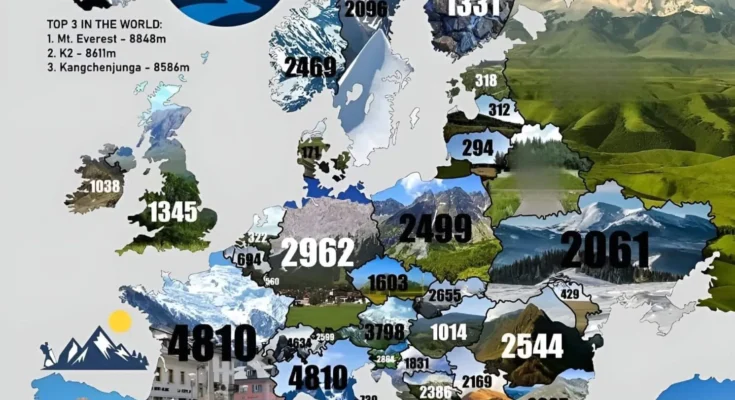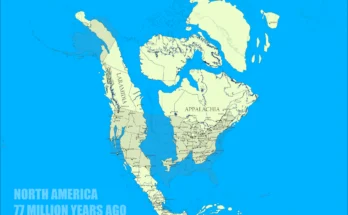Europe is a continent of stunning geographical diversity, from towering mountain peaks to picturesque coastlines. This map, recently published by Croatian mapmaker Dmitar Zvonimir, highlights (literally) the highest point in each European country, providing a fascinating glimpse into the dramatic elevation changes across the region. We are looking at some of the most notable peaks below the map.

Europe is home to some of the highest and most iconic mountain ranges in the world, with peaks towering high above the landscape. But not every country on the continent can boast towering summits. In fact, some countries have surprisingly modest highest points that stand in stark contrast to the towering mountains of the Alps or the Pyrenees.
To start on the top, Switzerland is known for its alpine grandeur, with its highest peak, Dufourspitze, reaching an impressive 4,634 meters above sea level. This is just one of the many towering giants in the Swiss Alps. And then there’s of course Mont Blanc, rising to 4,810 meters between the French Haute-Savoie and the Italian Valle d’Aosta regions (the peak’s “ownership” is often disputed by these countries, but according to a treaty signed in 1861 between France and the Kingdom of Sardinia-Piedmont, the border is actually at the highest point of Mont Blanc).

While it is commonly believed that Mont Blanc is the highest peak in Europe, that distinction actually belongs to Mount Elbrus in Russia (not indicated on the above map). This colossal summit stands at 5,642 meters above sea level, offering an entirely different experience than the gently rolling hills of the Netherlands, for example.

Oh, talking about the Netherlands: in this country, the highest point is not even a mountain at all, but a…well, let’s call it a hill…which reaches only 322 meters. Indeed, the Vaalserberg, which is also where the borders of the Netherlands, Belgium and Germany meet, is hardly what we typically think of when we consider Europe’s mountainous terrain.
Similarly, in Belgium, the highest point is the Signal de Botrange, which stands at just 694 meters. It might not have the grandeur of the Alps, but for Belgians, it is the highest accessible summit in their country.

Moving eastward to the Baltic States, the highest points are equally unassuming. In Estonia, the highest point is Suur Munamägi (Great Egg Hill), which peaks at 318 meters (1,043 ft), making it the tallest in the country but still very much a modest hill in comparison to the towering ranges further down south. Latvia’s highest point, Gaiziņkalns, reaches 312 meters, and Lithuania’s Aukštojas Hill tops out at 294 meters.

Across the continent, the difference between the highest points varies drastically. In Finland, the highest mountain is Mount Halti, which reaches 1,324 meters. It’s far from the heights of the Alps, but for Finns, it’s a source of pride, sitting within the picturesque landscape of the Arctic region. Then there is Slovenia, where the mighty Triglav reaches 2,864 meters—tall by European standards, though not a match for the soaring peaks of the Alps to the west.

Interestingly, some countries manage to surprise with their highest points. For example, Spain’s highest peak, Mount Teide, is not located on the mainland, but on the Canary Islands (which sit on the African continental plate geographically) and soars to 3,718 meters. Teide is actually a dormant volcano that rises majestically above the island of Tenerife. Its unique volcanic landscape, characterized by dramatic cliffs, lava flows, and barren terrain, has made it a popular filming location for science fiction movies.

On the other hand, the Baltic countries or the Netherlands aren’t the countries with the lowest “highest” point in Europe: that title goes to Monaco (161 meters), followed by Denmark (171 meters), and Malta (253 meters). But if we talk “proper” countries, and leave out microstates and principalities (sorry Monaco!), then we are left with Denmark’s highest point, Møllehøj. So let’s finish this post with that one. On this photo, it is actually obscured by the farm buildings. Quite unassuming, isn’t it?



